From one book (Virgil’s Aeneid) to more than 500,000 items today, the library has always been a source of knowledge, wisdom and social life at first Eastern Mennonite School, then Eastern Mennonite College and now Eastern Mennonite University.
Sadie A. Hartzler Library Director Marci Frederick combed carefully through the reports of previous directors to find the following chronological gems.
From 1917-1954, scant information is available, she notes. The first library director reports cover 1954-55 and go until 2004. Quotations come from those reports.
A few non-chronological tidbits, to start:
- A representative from Jeopardy! once called to talk about Amish furniture.
- All of the Historical Library librarians have been left-handed.
- Over the years, the library has loaned items to the Office of the President of the United States, the Central Intelligence Agency, the Supreme Court, and the library at Disney’s Animal Kingdom, among many other libraries on all continents except Antarctica. The Library of Congress once offered to send a car to EMU to pick up a rare book.
- Library staffers enjoy a convivial working relationship. In 2016, for Lois Bowman’s 80th birthday, library staff did the scramble over Bear Fence Mountain in Shenandoah National Park. This is just one of many summer outings over the years, including a tour of the Library of Congress.
- Creating “goodie plates” for student workers at Christmas is also an enjoyable tradition.
- Pranks in the library have a long and witty tradition. Sometime between 1996-98, pranksters placed a small vehicle (perhaps a trailer) without its wheels in front of the library’s main doors. A few weeks later, just before graduation, a Volkswagen Beetle appeared on the first landing of the main outside staircase. Library staff enlarged a bar code and pasted it on the car’s windshield.
October 10, 1925
The library’s first recorded accession for its book collection is Virgil’s Aeneid, with notes by Thomas Chase, published by Eldredge & Brother, Philadelphia, probably in 1885. Fifteen of the first 25 items added are Greek or Latin texts. (Librarian Sadie Hartzler also taught Latin.) The other ten are in English literature.
- First theological book received (accession #32): J. W. Beer’s The Jewish Passover and the Lord’s Supper (1811);
- First science book (accession #37): R. P. Williams’ Introduction to Chemical Science (1873)
- First education/psychology book (accession #74): Edward Brooks’ Mental Science and Methods of Mental Culture, Designed for the Use of Normal Schools, Academies, and Private Students Preparing to be Teachers (1881).
1925-1950s?
Prior to approximately 1938, books with suspect theology were marked with notations specifying the nature of their problems. Inside the front cover of James D. Dana’s Manual of Geology Treating of the Principles of the Science with Special Reference to American Geological History (4th ed., 1894) we find this: “Caution! The author accepts the Theory of Evolution and presents false opinions as scientific truths. Read Gen. 1:131 [sic].”
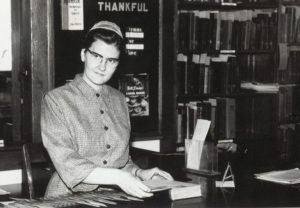
Well into the 1950s, some fiction books had certain words blacked out, and materials with questionable content (like Life magazine) were kept at the librarian’s desk. The library did not house the most problematic books, however; the Heresy Library was kept in the Dean’s Office. While these practices violate current professional library codes of ethics, it is surprising that the institution collected these problematic materials at all. Their collection suggests some effort to engage with the ideas they held, however questionable they were deemed to be.
1954-55
In June 1955, the total book collection was 19,933.
1955-56
Filmstrips and 8mm/16mm films begin to be acquired about this time. A microfilm machine was purchased.
1961-62
Keeping up with current research is recognized as important. Abstracting literature (Biological abstracts), indexes and review journals are added to meet Southern Association requirements. These types of literature provide greater access for faculty and students to the most recent research literature.
1962?
An audio-visual department (later “Learning Resources”) is formed within the library to provide film screening and sound amplification operators, and production services for graphics, audio, photography, and television. This department provides about half of the library student jobs (45 at its height in 1982-83). The longtime department head, Milo Stahl, leaves in 1984. Martin King takes over until his position is moved to Information Systems in 2009.
1962-63
Interlibrary loan traffic (received and lent) comprises 81 items, all books and dissertations.
1966-67
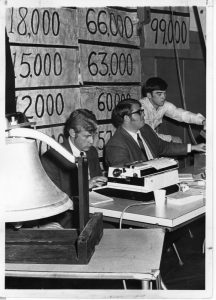
The library purchases The New York Times (NYT) on microfilm. Microfilm will play an increasing role in both providing access to new materials (like the NYT) and in preserving other materials (like print journals) in a more compact format.
1969-71
Design, fundraising and building of the new building. The “big move” of the collection took place on June 30, 1971 from 8:30 a.m. to 4:40 p.m.
1972-73
It was reported that the library staff donated time to cover the library in the evenings and on weekends.
Food machines appeared in the building.
Art gallery space was allocated in what had been designed as a third floor lounge, against the library’s wishes. The library continues to (more willingly) host gallery space today, now on the main floor.
Staff concerns, as noted in the library director’s report:
- Materials taken out and not returned, or returned late, or taken without being checked out;
- Noise: “too much visiting and talking too loudly;”
- “Moving about and misusing library furniture;”
- “lack of opportunity for formal orientation and instruction.”
The library did little teaching until the mid-1980s.
1973-74
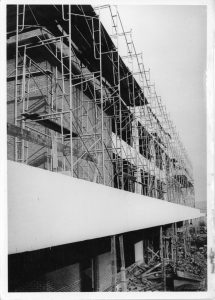
James O. Lehman was named director; former director Margaret Shenk remained on staff as technical services librarian until her retirement in 1984.
The Historical Library was already full, so walls were torn out to expand its footprint on the third floor.
1974-75
In May 1975, the library accessioned its 75,000th volume.
1975-76
The library becomes the first major user of computer technology when it joins the OCLC cooperative via SOLINET.
1976-77
The first specialized OCLC computer terminal is installed, enabling book cataloging that is shared nationally, interlibrary loan identification and ordering (two years later), and the production of catalog cards.
“It is quite possible that several pranks by students were indications that they were reminding us of the relative ease of getting into the library during off hours.” Pranks have continued to the present day. One time students set a library table with breakfast cereal boxes, bowls and spoons to represent the Serials (journals and magazines) collection. Sometime between 1996-98 pranksters placed a small vehicle (perhaps a trailer) without its wheels in front of the library’s main doors. A few weeks later, just before graduation, a Volkswagen Beetle appeared on the first landing of the main outside staircase. Library staff enlarged a bar code and pasted it on the car’s windshield.
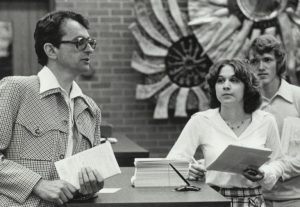
The Curriculum Library included 290 Flannelgraphs.
1979-80
Interlibrary loan traffic begins to increase with the possibility of ordering from a large electronic catalog (OCLC) covering hundreds of libraries.
Library book collections top 100,000 volumes.
1982-83
The Education Department was housed in the library while the Administration Building was being vacated for renovation.
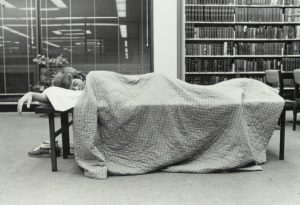
Classes are held in the library for the first time.
“Over half of the [75] students [surveyed] viewed the library as a social center.” Numerous couples report courting in the library.
1984-85
When James Madison University installed its first online catalog, James O. Lehman commented, “How soon do we go to this new approach? It is probably wise not to jump too quickly, although sometime in the next decade it may be necessary to plan for it.” Full implementation of the library homepage and web catalog took place in 1995-96.
“The EMC/S Library has not yet received pressure for access to a number of data bases, but it is quite conceivable that in the next decade we will need to consider those options.”
The first electronic security system was installed in the summer of 1985, despite concerns that it reflected a “lack of trust” of library users.
1985-86
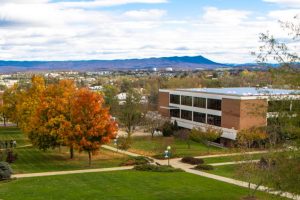
The building was officially named after Sadie A. Hartzler, the first librarian. The Historical Library acquired over 100 items concerning Dutch artist Jan Luyken, who is most famous for producing copperplate engravings for the second edition (1685) of Tieleman van Braght’s Het bloedig tooneel of martelaersspiegel, better known as The martyrs’ mirror.
1986-87
Audrey Shenk arrives to work with acquisitions. CD-ROMs are mentioned. Videotapes are added around this time.
1987-88
The Historical Library expands again. Two Apple IIe computers are added for word processing. Fire sensors and alarms are installed. This is the last year that filmstrips and slides are purchased.
The library participates in first-year orientation beginning in 1987.
1988-89
Access via phone line is provided to Knowledge Index, a collection of 75 databases from DIALOG.
1989-90
A Menno Simons conference is held in March 1990.
In 1989-90, a student attempting to hide in the building was caught twice by new Technical Services Librarian Jennifer Ulrich, which was a good thing for him, because he would have been locked in all weekend.
New reference librarian David Alleman provides instruction for 20 classes. “Information literacy” comes into the lexicon about 1996, and is added to all sections of College Writing.
1990-91
Historical Library head Grace Showalter dies on the day she was to have retired. Lois Bowman, who began working in the library in 1962, takes the position and continues until her retirement in 2014, when Simone Horst begins as special collections librarian.
A large number of filmstrips and slides are withdrawn.
1991-92
The library begins to add records for older materials to its computerized catalog holdings in OCLC.
There are five computers for staff use and seven for public use.
Scholar-in-residence Irvin Horst is honored with a dinner, a festschrift (Menno Simons, a reappraisal: essays in honor of Irvin B. Horst on the 450th anniversary of the Fundamentboek), and a plaque for the Special Collections room.
1992-93
The Historical Library is pressed for space again. The book collection tops 135,000 volumes.
1993-94
“Automation, networking and getting on the Internet will bring major changes, probably more than most library staffers can imagine.”
1994-95
The “cue room,” where films were set up for previewing, is transformed into a training room for computer users.
1995-96
James O. Lehman retired as director, remaining as university archivist until 2000.
The first two web-based databases, Britannica online and Project Muse, are added. Currently the library has over 90 indexes, abstracting services, and full-text journal sources, all searchable via a single search box.
1996-97
Boyd Reese serves as library director from 1996-2005.
1998-99
Library book collection tops 150,000 volumes.
2001-02
Nate Yoder begins working as university archivist.
2005-06

First electronic book collections added (11,715 titles).
Jennifer Ulrich serves as interim library director, 2005-07.
Added “Books for fun,” read-and-return popular books which don’t need to be checked out.
2006-07
Added patio furniture to the grounds in front of the library.
2007-08
Don Smeeton serves as director from 2007-2009. Dawn Nyce starts in the Main Library.
2009-10
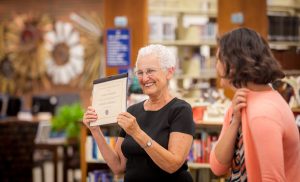
Former Provost Beryl Brubaker begins as director and serves until 2015.
Library hosts a “Virginia Women in History” exhibit honoring Joan Grayson of James Madison University.
2010-11
Stephanie Bush begins as instructional services librarian.
2012-13
Library hosts the traveling exhibit, “Manifold greatness: the creation and afterlife of the King James Bible.”
Digitization of The Weather Vane begins. Click here to read a timeline and here to view past issues.
2014-15
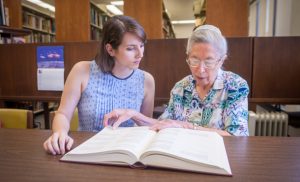
143,426 electronic books are added to bring the total e-book collection to 168,108, almost as large as the print collection of 172,730 items.
Simone Horst takes over from Lois Bowman as special collections librarian.
2015-16
Marci Frederick begins as director.
A discovery system, which enables searching all databases at once, is installed.
Interlibrary loan sends out 3,612 items and received 2,393 for a total of 6,005.
2016-17
Library book collection (print and electronic) passes 500,000 items.
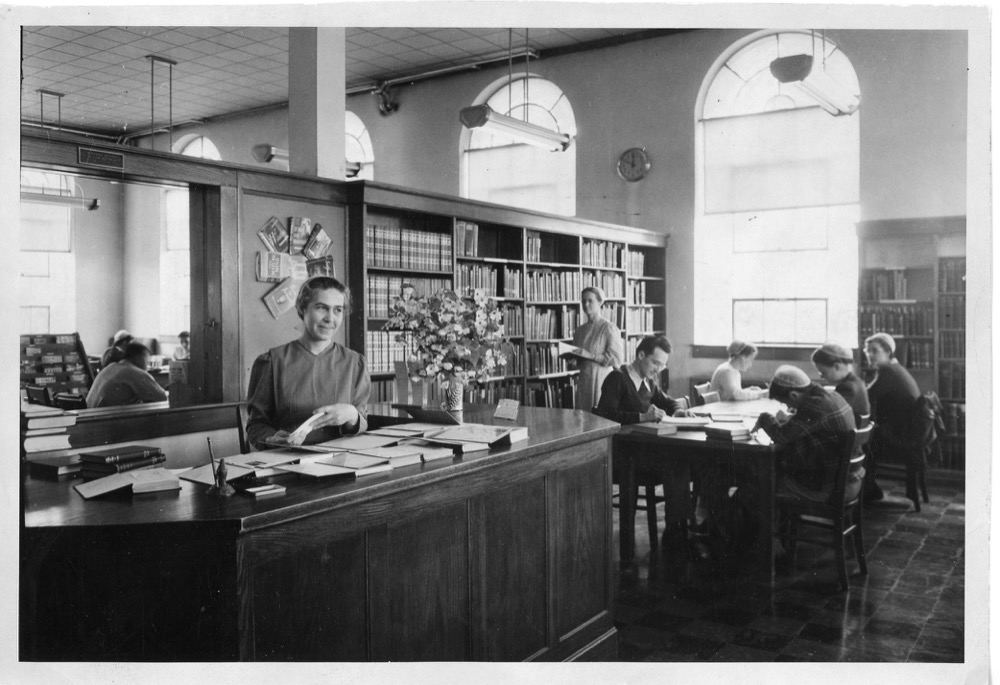
I love this library! Spent a lot of time there as an undergrad and some as a grad student. Great chronological history to read.